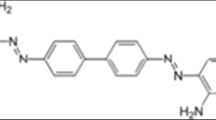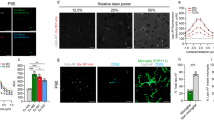Abstract
Senile plaque blue autofluorescence was discovered around 40 years ago, however, its impact on Alzheimer’s disease (AD) pathology has not been fully examined. We analyzed senile plaques with immunohistochemistry and fluorescence imaging on AD brain sections and also Aβ aggregation in vitro. In DAPI or Hoechst staining, the nuclear blue fluorescence could only be correctly assigned after subtracting the blue plaque autofluorescence. The flower-like structures wrapping dense-core blue fluorescence formed by cathepsin D staining could not be considered central-nucleated neurons with defective lysosomes since there was no nuclear staining in the plaque core when the blue autofluorescence was subtracted. Both Aβ self-oligomers and Aβ/hemoglobin heterocomplexes generated blue autofluorescence. The Aβ amyloid blue autofluorescence not only labels senile plaques but also illustrates red cell aggregation, hemolysis, cerebral amyloid angiopathy, vascular plaques, vascular adhesions, and microaneurysms. In summary, we conclude that Aβ-aggregation-generated blue autofluorescence is an excellent multi-amyloidosis marker in Alzheimer’s disease.






Similar content being viewed by others
References
Alzheimer’s disease facts and figures. Alzheimers Dement 2023, 19: 1598–1695.
Jia J, Xu J, Liu J, Wang Y, Wang Y, Cao Y. Comprehensive management of daily living activities, behavioral and psychological symptoms, and cognitive function in patients with alzheimer’s disease: A Chinese consensus on the comprehensive management of alzheimer’s disease. Neurosci Bull 2021, 37: 1025–1038.
Masters CL, Simms G, Weinman NA, Multhaup G, McDonald BL, Beyreuther K. Amyloid plaque core protein in Alzheimer disease and Down syndrome. Proc Natl Acad Sci U S A 1985, 82: 4245–4249.
Liu F, Sun J, Wang X, Jin S, Sun F, Wang T, et al. Focal-type, but not Diffuse-type, Amyloid Beta Plaques are Correlated with Alzheimer’s Neuropathology, Cognitive Dysfunction, and Neuroinflammation in the Human Hippocampus. Neurosci Bull 2022, 38: 1125–1138.
Dowson JH. A sensitive method for the demonstration of senile plaques in the dementing brain. Histopathology 1981, 5: 305–310.
Kwan AC, Duff K, Gouras GK, Webb WW. Optical visualization of Alzheimer’s pathology via multiphoton-excited intrinsic fluorescence and second harmonic generation. Opt Express 2009, 17: 3679–3689.
Gao Y, Liu Q, Xu L, Zheng N, He X, Xu F. Imaging and spectral characteristics of amyloid plaque autofluorescence in brain slices from the APP/PS1 mouse model of alzheimer’s disease. Neurosci Bull 2019, 35: 1126–1137.
Fu H, Li J, Du P, Jin W, Gao G, Cui D. Senile plaques in Alzheimer’s disease arise from Aβ- and Cathepsin D-enriched mixtures leaking out during intravascular haemolysis and microaneurysm rupture. FEBS Lett 2023, 597: 1007–1040.
Fu H, Ma Y, Yang M, Zhang C, Huang H, Xia Y, et al. Persisting and increasing neutrophil infiltration associates with gastric carcinogenesis and E-cadherin downregulation. Sci Rep 2016, 6: 29762.
Kalaria RN, Sepulveda-Falla D. Cerebral small vessel disease in sporadic and familial alzheimer disease. Am J Pathol 2021, 191: 1888–1905.
Cullen KM, Kocsi Z, Stone J. Microvascular pathology in the aging human brain: Evidence that senile plaques are sites of microhaemorrhages. Neurobiol Aging 2006, 27: 1786–1796.
Stone J. What initiates the formation of senile plaques? The origin of Alzheimer-like dementias in capillary haemorrhages. Med Hypotheses 2008, 71: 347–359.
Kumar-Singh S, Cras P, Wang R, Kros JM, van Swieten J, Lübke U, et al. Dense-core senile plaques in the Flemish variant of Alzheimer’s disease are vasocentric. Am J Pathol 2002, 161: 507–520.
Miyakawa T, Shimoji A, Kuramoto R, Higuchi Y. The relationship between senile plaques and cerebral blood vessels in Alzheimer’s disease and senile dementia. Morphological mechanism of senile plaque production. Virchows Arch B Cell Pathol Mol Pathol 1982, 40: 121–129.
Niyangoda C, Miti T, Breydo L, Uversky V, Muschol M. Carbonyl-based blue autofluorescence of proteins and amino acids. PLoS One 2017, 12: e0176983.
Fricano A, Librizzi F, Rao E, Alfano C, Vetri V. Blue autofluorescence in protein aggregates “lighted on” by UV induced oxidation. Biochim Biophys Acta Proteins Proteom 2019, 1867: 140258.
Shirahama T, Skinner M, Westermark P, Rubinow A, Cohen AS, Brun A, et al. Senile cerebral amyloid. Prealbumin as a common constituent in the neuritic plaque, in the neurofibrillary tangle, and in the microangiopathic lesion. Am J Pathol 1982, 107: 41–50.
Wieczorek E, Wygralak Z, Kędracka-Krok S, Bezara P, Bystranowska D, Dobryszycki P, et al. Deep blue autofluorescence reflects the oxidation state of human transthyretin. Redox Biol 2022, 56: 102434.
Chan FTS, Kaminski Schierle GS, Kumita JR, Bertoncini CW, Dobson CM, Kaminski CF. Protein amyloids develop an intrinsic fluorescence signature during aggregation. Analyst 2013, 138: 2156–2162.
Attems J, Jellinger KA. The overlap between vascular disease and Alzheimer’s disease—lessons from pathology. BMC Med 2014, 12: 206.
Zhang R, Xu X, Yu H, Xu X, Wang M, Le W. Factors influencing alzheimer’s disease risk: Whether and how they are related to the APOE genotype. Neurosci Bull 2022, 38: 809–819.
Aliev G. Is Non-Genetic Alzheimer’s disease a Vascular Disorder with Neurodegenerative Consequences? Journal of Alzheimers Disease 2002, 4: 513–516.
de la Torre JC. Vascular basis of Alzheimer’s pathogenesis. Ann N Y Acad Sci 2002, 977: 196–215.
Cullen KM, Kócsi Z, Stone J. Pericapillary haem-rich deposits: Evidence for microhaemorrhages in aging human cerebral cortex. J Cereb Blood Flow Metab 2005, 25: 1656–1667.
Alterations of the cerebral capillary bed in the senile dementia of Alzheimer. Ital J Neuro Sci 1987, 8: 457–463.
Bu XL, Xiang Y, Jin WS, Wang J, Shen LL, Huang ZL, et al. Blood-derived amyloid-β protein induces Alzheimer’s disease pathologies. Mol Psychiatry 2018, 23: 1948–1956.
Sun HL, Chen SH, Yu ZY, Cheng Y, Tian DY, Fan DY, et al. Blood cell-produced amyloid-β induces cerebral Alzheimer-type pathologies and behavioral deficits. Mol Psychiatry 2021, 26: 5568–5577.
Acknowledgements
This work was supported by the National Natural Science Foundation of China (81472235), the Shanghai Jiao Tong University Medical and Engineering Project (YG2021QN53, YG2017MS71), the International Cooperation Project of National Natural Science Foundation of China (82020108017), and the Innovation Group Project of National Natural Science Foundation of China (81921002). We want to thank Dr. Ma Chao and Dr. Qiu Wenying for providing AD tissue sections from the National Human Brain Bank for Development and Function, Chinese Academy of Medical Sciences, and Peking Union Medical College, Beijing, China. In addition, we thank Housheng Wang, Pingxin Liu, Xiaoyi Bao, and Jun Wang for their excellent lab assistance.
Author information
Authors and Affiliations
Corresponding author
Ethics declarations
Conflict of interest
The authors declare that there are no conflicts of interest.
Rights and permissions
Springer Nature or its licensor (e.g. a society or other partner) holds exclusive rights to this article under a publishing agreement with the author(s) or other rightsholder(s); author self-archiving of the accepted manuscript version of this article is solely governed by the terms of such publishing agreement and applicable law.
About this article
Cite this article
Fu, H., Li, J., Zhang, C. et al. Aβ-Aggregation-Generated Blue Autofluorescence Illuminates Senile Plaques as well as Complex Blood and Vascular Pathologies in Alzheimer’s Disease. Neurosci. Bull. (2024). https://doi.org/10.1007/s12264-023-01175-x
Received:
Accepted:
Published:
DOI: https://doi.org/10.1007/s12264-023-01175-x




